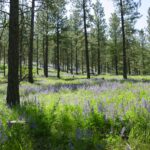WINTHROP –The North Central Washington Forest Health Collaborative (NCWFHC) and its partners celebrated six years of work to accelerate terrestrial and aquatic restoration on the Okanogan-Wenatchee National Forest. The NCWFHC held a full day meeting on May 1, 2019 at Sun Mountain Lodge in Winthrop, WA, an evening celebration, and then toured nearby forest health and salmon recovery projects on May 2nd.
George Geissler, State Forester & Deputy Supervisor for Wildfire & Forest Health, Department of Natural Resources (DNR), provided a keynote address focused on the DNR Wildfire Plan and 20-year Forest Health Plan, and alignment with the NCWFHC’s efforts. He also discussed prescribed fire and smoke management priorities, shared stewardship with the Department of Fish and Wildlife and the Forest Service, and legislative priorities related to forest health and wildfire budgets. The State Forester also reviewed other priorities for 2019 including increasing capacity for forest health treatments and wildland fire suppression at DNR with a new forest health division. State Forester Geissler said, “We have a large focus on forest health and we see collaboratives as extremely relevant in the forest health process.” He added, “I believe in allowing people to do what they do best and providing support for our employees and partners is a high priority. I am invested in forest health and my career is truly a career of passion.”
In order to meet the challenge of increasing the pace and scale of restoration, the NCWFHC was formed in 2013, and is facilitated by the Upper Columbia Salmon Recovery Board (UCSRB). NCWFHC is a diverse group of organizations including timber industry, conservation groups, and local, state, federal and tribal governments. For the past six years, the NCWFHC has leveraged resources and built consensus for landscape-scale forest restoration projects on the OWNF lands. The NCWFHC and the OWNF are partnering to double the footprint of restoration by building early consensus on potential projects, increasing Forest Service capacity for environmental analyses, and spreading the word about the importance of having more resilient forests and watersheds.
Treatments such as non-commercial thinning, road maintenance or decommissioning, brush removal, prescribed burning, removal of fish passage barriers, and commercial harvest are the most widely used active restoration treatments, while strategic management of natural disturbances can complement these activities. The OWNF encompasses more than 4 million acres in Washington State and stretches for a distance of about 180 miles from the Canadian border to the Goat Rocks Wilderness.
Further information:
Department of Natural Resources: https://www.dnr.wa.gov/
North Central Washington Forest Health Collaborative: http://www.ncwfhc.org
Upper Columbia Salmon Recovery Board: http://www.ucsrb.org


